Warning: Peppers are powerful plants. Take precautions when preparing fresh peppers and when drying the pods. We suggest that you wear protective gloves, goggles and a good dust mask when handling pepper pods, especially after the drying process and during the crushing process. We also suggest doing the crushing out of doors, if possible. Be sure not to touch your face, eyes, nose or mouth while handling the dry peppers, and even after using gloves, be sure to wash your hands and arms thoroughly with soap and water. We offer no guarantees with the drying methods described here, nor do we take responsibility for any results, including watery eyes.
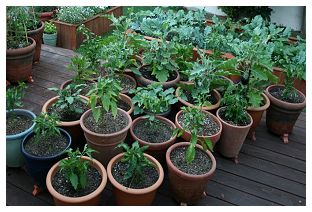 A few well placed pepper plants in your garden will supply you with an abundance of pepper pods to last through the year. It's fun to grow a diverse selection of pepper types, not only because of their ornamental beauty, but in order to fill any type of recipe you might wish to follow.
A few well placed pepper plants in your garden will supply you with an abundance of pepper pods to last through the year. It's fun to grow a diverse selection of pepper types, not only because of their ornamental beauty, but in order to fill any type of recipe you might wish to follow.
The photo here shows at least seven different peppers in containers on a patio deck in the old southwest section of Reno. You might want to double or triple up on types you will be using often, such as Anaheim and Jalapeno.
The containers are typically 10" to 12" ceramic pots (we have many beautiful containers to choose from at our garden shops). The soil is an organic potting mix chosen for its ability to drain well. Remember: pepper plants are tropical in origin which means they love lots of sun, lots of heat, a good dose of daily water, but they also demand a soil that drains well. That is, heat and sun are automatic during our region's growing season, but you will need to supply the water and make sure your peppers are not sitting in soggy soil.
Once your plants begin producing, you will have fresh pepper pods available for the picking through summer and autumn days and the variety will entice you to experiment with recipes you might not have tried before. If your plants are in containers and you have room inside with sunny exposure, as the colder days begin to impact upon the valley, you can bring your plants indoors for extended production. But for most, the days before the killing frost mark the time of harvest.
The easiest way to prepare your pepper plants for drying is to simply cut the stem at ground level, then hang the entire plants -- leaves and all -- upside down in a cool, dark place such as the garage. Leave them to dry like this the entire winter. This is the slowest way to dry your peppers, but there are advantages: many peppers, such as Anaheim and Jalapeno will retain enough moisture for much of the winter that you can use them just as you would fresh peppers (for stuffing, poppers, etc.). Plus, the branches will provide plenty of space for air circulation and the pepper pods will retain their bright colors and the seeds and flesh will be full of flavor when the drying process is complete.
Another way to dry your peppers is to remove the peppers from the plants at harvest time. Leave the fresh peppers whole and be sure to include the stem when you pick them (shred the plants and add the greens to your compost pile). Use a strong needle and thread to loosely sew the stems together. Be sure to leave enough space between each pepper pod to ensure proper air circulation. Hang the clusters up to dry, preferably in a cool, dark place, but many people choose to hang their pepper clusters in places where they can be seen and enjoyed while they dry, like in the kitchen.
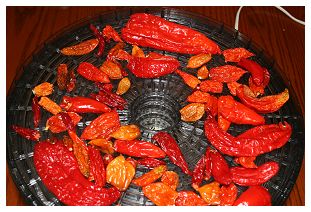 If you have a dehydrating machine, you can also dry your pepper harvest mechanically. Remove the stems, then lay out the peppers in the trays so that they do not overlap.
If you have a dehydrating machine, you can also dry your pepper harvest mechanically. Remove the stems, then lay out the peppers in the trays so that they do not overlap.
For fast, even drying, you might want to cut the peppers in half, but realize that the seeds will prove to be a problem at this point of the drying process. Either you will need to discard the seeds before setting them into the dryer, or expect many or most of them to find their way to the bottom of the dehydrator. If you do cut the pepper pods in half, place the skin side away from the source of heat and air.
Make sure you place your dehydrator in a well ventilated area as this method will produce hot pepper fumes that will definitely permeate the drying area. If your dehydrator's temperature can be adjusted, dry your pods at 100 degrees Fahrenheit. It will take several days. Your final, intended result will be the same as natural drying.
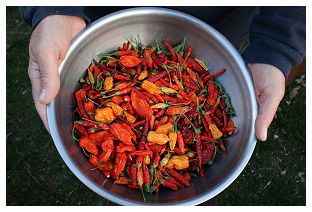 This bowl of dried peppers is the result of hanging the entire plants in the dark, in the garage for the entire winter. As an experiment, we combined samples from every type of plant we grew. By late February, the pepper pods were dry and crispy, ready for crushing and air-tight storage. The pods broke easily from the equally dry stems of the plants. We added the stems to the compost.
This bowl of dried peppers is the result of hanging the entire plants in the dark, in the garage for the entire winter. As an experiment, we combined samples from every type of plant we grew. By late February, the pepper pods were dry and crispy, ready for crushing and air-tight storage. The pods broke easily from the equally dry stems of the plants. We added the stems to the compost.
At this point, the thing to do is to put on your dust mask, goggles and gloves. If you want your hands to be all warm and tingly for the next few days, leave off the gloves, but we don't recommend it. Snap off the stems and save them for the compost. We definitely recommend that you do this on a nice windless day out of doors as the dust from the dried peppers will become airborne. Some of the dust will be very fine and remain in the air for quite awhile. If you do this indoors, expect the cat to be sneezing and the dog to be hacking. Indoor processing might even induce an abnormal level of snoring at night for a day or two.
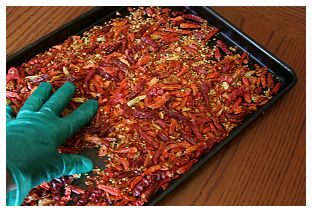 Another way to dry peppers is with an oven. If you are drying large or long peppers, you can use the oven racks and prep the pods as you would for the dehydrator. You won't want to cut the pods in half, though, as you'll loose the seeds to the bottom of the oven.
Another way to dry peppers is with an oven. If you are drying large or long peppers, you can use the oven racks and prep the pods as you would for the dehydrator. You won't want to cut the pods in half, though, as you'll loose the seeds to the bottom of the oven.
To retain the seeds, place the pods in baking sheets; you can leave them whole or cut them in half. Set the oven to a low temperature -- 100 to 150 degrees Fahrenheit -- and prop the oven door open slightly. If you have a convection oven, you won't need to prop the door open since air will be circulating automatically.
Keep an eye on your peppers. Turn them over occasionally for even drying, especially if they're in baking sheets. Out of the oven, let them cool completely. Remember to put on your gloves, goggles and dust mask before you crush the pods.
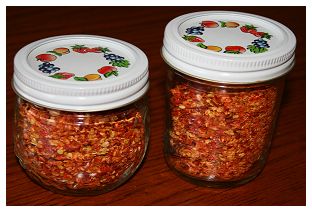 If you crush the pepper pods to spice sized consistency, you can put the results in small air-tight jars for kitchen use. These make nice gifts, especially for those who don't have gardens of their own.
If you crush the pepper pods to spice sized consistency, you can put the results in small air-tight jars for kitchen use. These make nice gifts, especially for those who don't have gardens of their own.
You can also skip the crushing step, leaving the peppers in their original shape and size, then place them in tall quart sized, air-tight jars. These peppers can then be soaked in water to rehydrate them. The rehydrated pods won't have the exact consistency of fresh peppers, but they're still fun to use, especially in sauces.
To good health, good food, good friends and good weather!


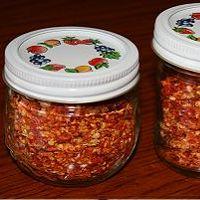
 A few well placed pepper plants in your garden will supply you with an abundance of pepper pods to last through the year. It's fun to grow a diverse selection of pepper types, not only because of their ornamental beauty, but in order to fill any type of recipe you might wish to follow.
A few well placed pepper plants in your garden will supply you with an abundance of pepper pods to last through the year. It's fun to grow a diverse selection of pepper types, not only because of their ornamental beauty, but in order to fill any type of recipe you might wish to follow. If you have a dehydrating machine, you can also dry your pepper harvest mechanically. Remove the stems, then lay out the peppers in the trays so that they do not overlap.
If you have a dehydrating machine, you can also dry your pepper harvest mechanically. Remove the stems, then lay out the peppers in the trays so that they do not overlap. This bowl of dried peppers is the result of hanging the entire plants in the dark, in the garage for the entire winter. As an experiment, we combined samples from every type of plant we grew. By late February, the pepper pods were dry and crispy, ready for crushing and air-tight storage. The pods broke easily from the equally dry stems of the plants. We added the stems to the compost.
This bowl of dried peppers is the result of hanging the entire plants in the dark, in the garage for the entire winter. As an experiment, we combined samples from every type of plant we grew. By late February, the pepper pods were dry and crispy, ready for crushing and air-tight storage. The pods broke easily from the equally dry stems of the plants. We added the stems to the compost. Another way to dry peppers is with an oven. If you are drying large or long peppers, you can use the oven racks and prep the pods as you would for the dehydrator. You won't want to cut the pods in half, though, as you'll loose the seeds to the bottom of the oven.
Another way to dry peppers is with an oven. If you are drying large or long peppers, you can use the oven racks and prep the pods as you would for the dehydrator. You won't want to cut the pods in half, though, as you'll loose the seeds to the bottom of the oven. If you crush the pepper pods to spice sized consistency, you can put the results in small air-tight jars for kitchen use. These make nice gifts, especially for those who don't have gardens of their own.
If you crush the pepper pods to spice sized consistency, you can put the results in small air-tight jars for kitchen use. These make nice gifts, especially for those who don't have gardens of their own.